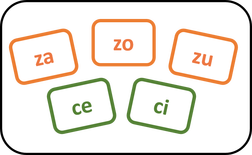 In a previous post, I mentioned that spelling rules have a limited role in the development of spelling. One of the reasons for that limited role is the fact that our mind does not have the time to stop and recall a specific rule during real time writing. Instead, our mind relies more strongly in the visual memory of the word. After repeated exposure to a written word, as well as after repeatedly writing that word for years, the visual image of that written word is engraved in our mind. This allows us to read and write more quickly and confidently. And it’s that stored image of a word that allows us to reject a misspelled word with a feeling that “it looks bad”.  However, students keep asking for rules … and then forgetting them. There is nothing wrong with forgetting a rule, but only if the image of that word is strongly engraved in the mind so that the rule is not really needed. In a workshop for prospective teachers (heritage language themselves), I asked the students: “Why do you think spelling is so difficult?” And a few responded: “Because students are lazy and don’t study the rules”. Then, I proceeded to explain a very simple spelling rule: when you have to choose between Z and C, Z is used before A, O, U; and C is used before E and I. And I gave a few examples. Students told me they understood the rule--and most of them were familiar with it already. Immediately after that, I gave them a dictation of words, and I told them that none of them were spelled with S, only Z or C. Among those words were: cine, cena, zapato, cereza, hice, realicé and cero. Can you guess which ones many of them got wrong? Yes, they were realicé and cero. More than half of the class wrote zero, and more than one third wrote realizé. There were no errors in any of the other words, despite the fact that they followed the same rule. Students were obviously swayed by the visual image of zero and realize in English. When I showed students why those spellings were wrong, according to that simple rule they had just learned, a few still “complained” that cero and realicé looked wrong. Students were not lazy, or forgetful; the memory of the image of zero and realize simply had a greater weight. This is not so strange. When we see a friend on the street, we recognize his or her face because we have a stored memory of it, not because we “know” some facts about that friend’s face. When we see a red light it just feels right to stop; we do not need to think about the rule: green > go; red > stop. For cases in which the spelling of a word goes against a strong image of a word, students will need negative instruction (that is, what NOT to write) and many opportunities to strongly engrave the image of that word in their minds. Here are some other words similar to cero and realicé: analicé, docena, cebra, bronce, utilicé, trapecio. *********************** Have you encountered any interesting spelling error (frequent or not) you would like me to write about? Feel free to let me know in a comment.
4 Comments
José
2/6/2018 09:28:29 pm
What is something I can do when my students from Spanish for Native Speakers 1, can’t hear the distinction in where the emphasis of a word is? I’ve explained it over and over, and they are understanding how to divide words into syllables, what the sílaba tónica is, what diptongos are, what aguda, llanas, esdrújulas, and sobresdrújulas are but... when I write a word on the board, they can’t figure out what the sílaba tónica is when the word doesn’t have an accent.
Reply
2/7/2018 07:31:21 am
Thank you, José. So many teachers stumble with this issue. I will write about this on my next post, and I will include some tips. What worked for you as a student?
Reply
Jose Flores
2/10/2018 06:03:26 pm
Awesome! I would overly stress all the vowels while saying the word, and most of the time that worked. If I stress each syllable individually, it’s hard to distinguish, but if I say something like, “PAlabra, paLAbra, palaBRA” that helped me. The other way, was once I knew the accent/syllable rules, I would think of it the opposite way.
Reply
Leave a Reply. |
BLOG ON SPELLING
This is a blog about spelling in Spanish Heritage Language Learners. Some posts will be in Spanish and some in English. Feel free to ask your questions in the comments section.
Archives
September 2023
Popular Posts
Made-up words and other fipers. Tips for teaching stress marks. Los hablantes nativos y la ortografía |

